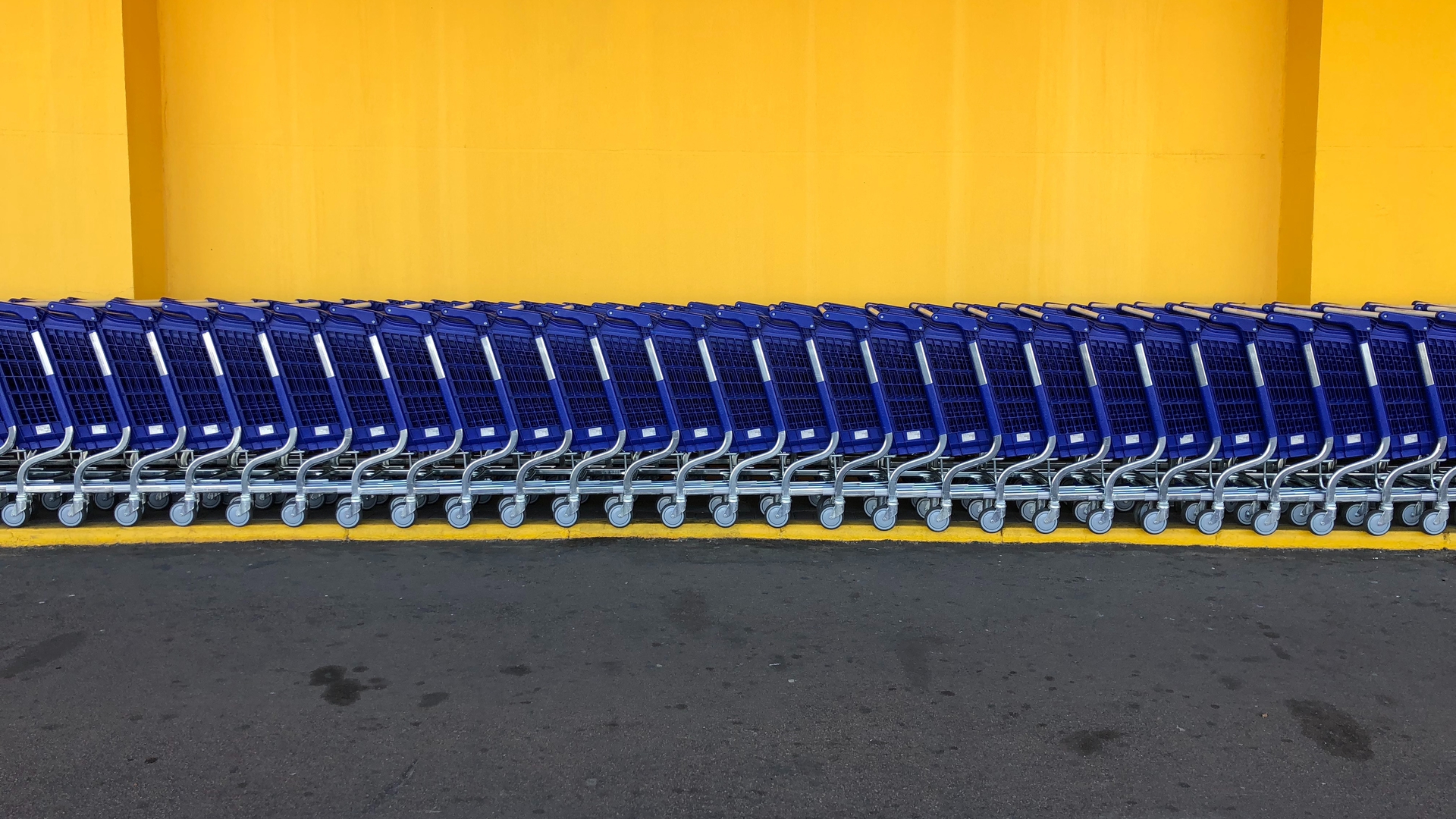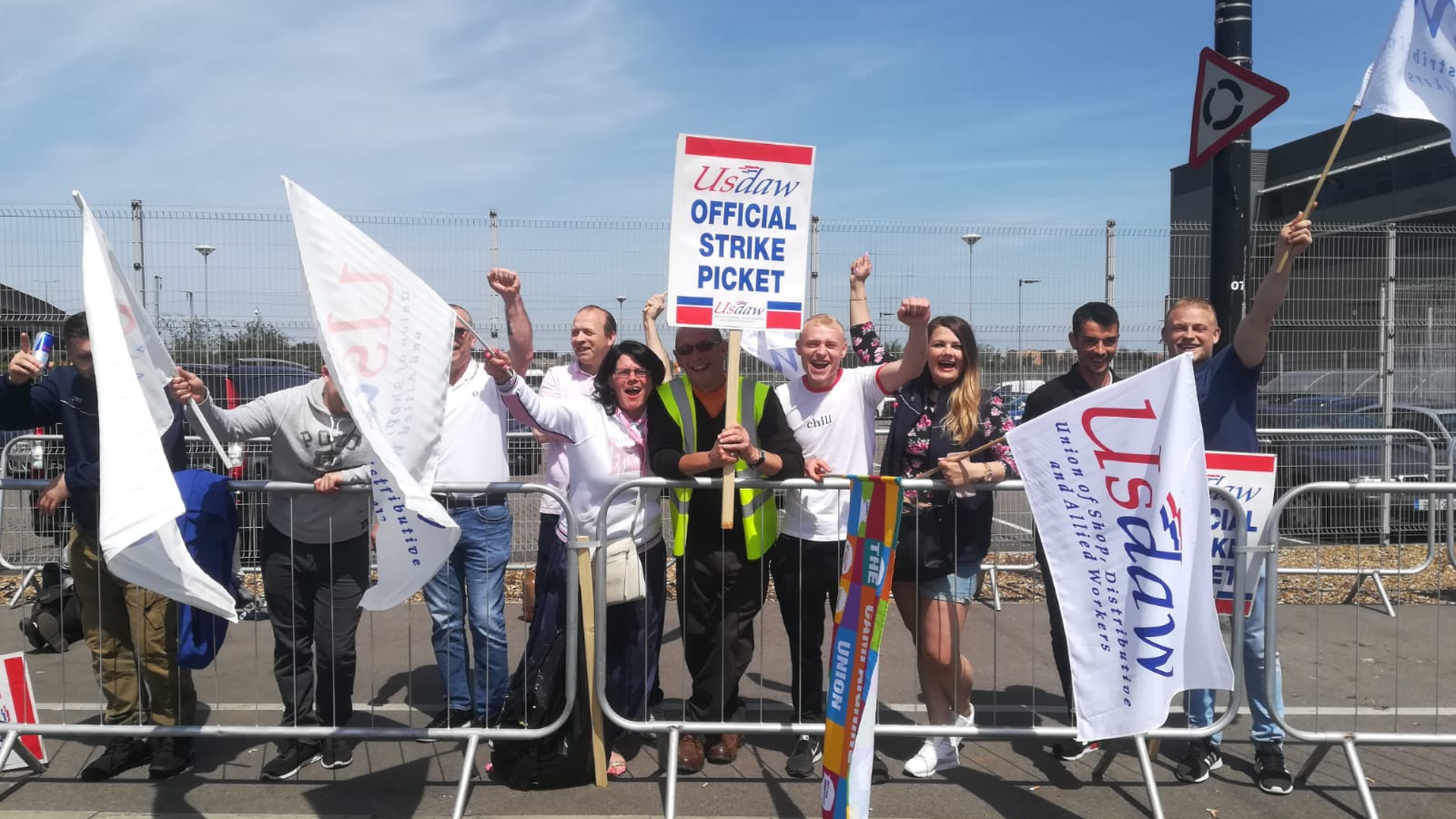Breaking the Chain: Building Worker Power under Monopoly Capitalism
by
Hettie O’Brien (@hettieveronica)
August 16, 2018
Featured in The Worker and The Union (#3)
Together with the intensification of labour, mergers and market concentration have transferred power from workers to businesses

theory
Breaking the Chain: Building Worker Power under Monopoly Capitalism
by
Hettie O’Brien
/
Aug. 16, 2018
in
The Worker and The Union
(#3)
Together with the intensification of labour, mergers and market concentration have transferred power from workers to businesses
Every morning, thousands of commuters in the UK board trains made by Bombardier, Europe’s largest rail-equipment manufacturer. They scroll through their phones to check Facebook, Twitter and Whatsapp, using data plans from the likes of O2, Vodafone or Three. At work, they type on an Apple, HP, Lenovo or Dell computer. Some have brought their own lunches. Perhaps their groceries were from Sainsbury’s, likely soon to merge with Walmart subsidiary Asda. Or maybe they shopped at Tesco, which recently acquired food wholesaler Booker. After work, they might head for a drink with friends. If they choose a Budweiser, Corona, or Stella Artois, it will be made by AB InBev, the largest beer company in the world.
Life gets blander as companies get bigger. Despite the appearance of choice, many of the things we buy are the products of only a few firms. Large corporations, built for profit, have increasingly come to prescribe the mundane features of everyday life. Many of these companies grew in the 1980s and 90s, when the globalisation of trade increased the pressure on firms to compete. Domestic companies were faced with competition from foreign interlopers, while the migration of manufacturing eastwards placed downward pressure on prices. Mergers and acquisitions became a way to dominate markets. As Anwar Shaikh describes, competition – as it operates in the real world – is akin to warfare. In their fight for dominance, today’s monopolies span the globe, compete for data, aggressively buy out competitors and occupy different markets at the same time.
Corporate expansion often comes at an expense to workers. Economist Howard Botwinick notes that market concentration plays a “major role in tipping the balance against labour in industries such as coal, meat-packing, printing and steel”. When they go global, companies spread their tentacles across multiple subsidiaries and subcontractors. Conglomerates are thus better placed to resist strikes. Just as Amazon can blow out competitors by subsidising one strand of its business with profits from another, a strike may be easier to resist when a company can shift production to another area of its empire.
From the mid 1980s, companies began to ramp up the pressure on workers in order to squeeze as much productivity from their employees as possible. Space and time became key weapons in the armoury of corporate warfare. The history of manufacturing shows us that this is nothing new; from brick-making in Roman foundries to Henry Ford’s production line, business owners have always attempted to extract maximum productivity, by breaking jobs into smaller pieces. But this approach reached fever pitch in the 1980s. Lean production, or “Toyotaism”, divided work not into hours or minutes, but seconds. Japanese engineer Taiichi Ohno devised what became known as the “Toyota minute” - a standard prescribing 57 seconds of work per minute, with 3 seconds of downtime. In doing so, he gave managers greater control of their employees. But he also, effectively, altered the very concept of time within the factory.
Together with the intensification of labour, mergers and market concentration have transferred power from workers to businesses. As New York Attorney General candidate Zephyr Teachout put it on Twitter, “common sense tells you that … concentrated power isn’t right. These giant mergers tend to hurt workers and democracy, not just prices – they lessen the control of the little guy”. Monopoly power conflicts with a deep-rooted notion of individual freedom that enables the “little guy” – the worker – to exercise his bootstraps. Teachout’s words stem from a tradition of liberal political philosophy that sees worker agency as a matter of wage bargaining. Workers sell their labour on the market as a commodity, so it’s in their interest to get the best price. Corporate monopolies thwart this ability since fewer companies mean workers have fewer workplaces to choose from. At this point, liberals argue, the state should step in. Antitrust intervention breaks up monopolies and restores true competition to the free market, protecting workers by enforcing a level playing field where multiple companies compete on more favourable wage terms.
But this idea labours under an illusion that making markets more competitive will equalise the balance between workers and business owners. As long as worker power is limited to the choice of where to sell ones’ labour rather than how to share in its profits, breaking up monopolies will be a palliative, not a panacea. This liberal tradition riled Marx, who accused thinkers such as Bentham of limiting the notion of worker agency to circulation rather than production. “He, who before was the money-owner, now strides in front as a capitalist; the possessor of labour-power follows as his labourer”, Marx wrote. In other words, when we look critically at a situation where the only power that workers have is the choice of where to apply for a job, we begin to see how this situation is heavily tilted in favour of corporations. Restoring competition to concentrated markets will do little to change the fact that when workers bring their “own hide to market”, they have “nothing to expect but – a hiding”, Marx wrote.
Any challenge to unwieldy corporate power won’t come from restoring competition; it’ll have to come from below. But how might this be possible? Labour economist Kim Moody notes that octopus-like corporations have weaknesses that may be ripe for resistance. This is the argument that Jake Alimahomed-Wilson takes up in the edited volume Choke Points, which examines the possibilities for resistance within the supply chains and logistics industries that have become essential ingredients of 21st-century capitalism. This could take two potential forms.
First, the lean production process favoured by Toyota’s engineers, now widespread among global companies, can be antithetical to codifying knowledge about how workers actually do their jobs. This creates new gaps for micro-acts of resistance. In an article for Harvard Business Review, James Womack and Daniel Jones argue that companies shouldn’t stop at applying the values of lean production to particular areas of manufacturing. Instead, they should become entirely “lean enterprises”, cutting the human effort, tools, time and resources needed to deliver a service. Firms like Deliveroo register this shift from lean production to lean enterprise, stripping the number of overheads by placing staff on precarious contracts, managing them remotely via apps, and demanding that they, the workers, pay for their own uniforms and transport.
Yet the shift to becoming entirely “lean” also involves surrendering aspects of management oversight. App-based employment leaves gaps where management is lacking – or absent. As one Deliveroo driver in Scotland – who wished to remain anonymous – told me; “we have a very big ‘fuck this shit’ attitude now”. This means using the algorithmic tools designed to reap profits against the companies that designed them; as Gavin Kelly wrote recently in the Financial Times, “data could be used to calibrate the optimal moment for workplace disruption and ‘go-slows’”. Intimate knowledge of a job and opportunities for snoozing on company time opens gaps that are exacerbated by absentee or robot management. In their attempts to create leaner and more “efficient” modes of production by shedding staff numbers and paying riders per delivery, Deliveroo’s methods may disrupt the ethic of total management control proffered by Toyota’s industrialists.
Sprawling corporations may also open spaces for resistance at a different scale. Under the same competitive pressures that shaped companies into global monopolies, the growth of the logistics industry resulted in tightly-coordinated supply chains and restructured the flow of goods across the world. Rationalising the organisation of space gave Toyota a competitive advantage in the 1980s after it pioneered its “just-in-time” production process. A key aspect of this process was cutting inventories. To create value, capital must move: just as Deliveroo doesn’t pay drivers waiting around for deliveries, static products in a warehouse are dead capital. But the problem of having a supply chain without an inventory is that each node has to operate in sync with others. It has to flow. As David Harvey puts it, “if one link in the spatiotemporal chain is stopped by, for example, a strike, then everything has to close down because there is no inventory”. In short, many links in a chain make global monopolies more vulnerable to collective action.
Organising these nodes can challenge capitalism’s reliance on the smooth circulation of goods. But it requires awareness of the critical scale of one’s work and a clear sense of how it ties into a global picture. For these reasons, the shipping industry has long been a site of worker resistance. “The nature of marine transport – moving goods, people, and information – explains why longshore workers … are so worldly”, the historian Peter Cole writes. Struggles can gain traction as workers cognise the significance of their daily grind within an interconnected system of global trade that supersedes the local. When coupled with links of solidarity between workers on other sides of the world, these sites of resistance can prove powerful. During South Africa’s apartheid regime, solidarity was magnified between dockers in South Africa and San Francisco, leading to a wave of strikes and boycotts in the bay area and Durban port. Both groups of dockers understood their critical position in the global economy and mobilised behind an ideologically pan-African struggle. Recognizing one’s work through a global lens can bolster working-class internationalism. It can exploit weaknesses within supply chains even as technological developments like the introduction of shipping containers threaten to eradicate jobs and destroy unions.
But there’s a problem. Mergers lead to job losses frequently packaged in the language of “restructuring”. And as companies develop technologies that do routine jobs cheaper, labourers may lose even more bargaining power. Rather than cede influence to workers, the exercise of collective action through strikes and boycotts may push companies to automate with alacrity.
But this is where the state – or more specifically, policies formed through political struggle and enacted by a democratic body at scale – can intervene. In recognition of the severe disadvantages that apartheid had on half of its population, South Africa included a clause in its 1998 competition act called the “Public Interest Test”. This detail limited companies from firing workers following a merger and is extremely unpopular with corporate lackies for its allegedly “anticompetitive” effects. Apartheid’s legacy forced politicians to pick which side of history they were on; largely black working-class labourers or largely white business owners. The test was adopted so black citizens could have equal opportunities to participate in the economy, preventing companies from firing employees through mergers that benefited only business owners. “Restructuring” is a passive term that suggests a process without an agent; South Africa’s test affirmed that such processes are a political choice, not an economic inevitability.
From Tyrell Corp in Blade Runner to Resident Evil’s Umbrella Corporation, the conglomerate has become an object of dystopian fear. For workers, this fear is realized as low wages and the transfer of power towards ever-larger businesses. But these systems also have inherent weaknesses and political contingencies that open new gaps and spaces for rebellion, both small and large.
Featured in The Worker and The Union (#3)
author
Hettie O’Brien (@hettieveronica)
Subscribe to Notes from Below
Subscribe now to Notes from Below, and get our print issues sent to your front door three times a year. For every subscriber, we’re also able to print a load of free copies to hand out in workplaces, neighbourhoods, prisons and picket lines. Can you subscribe now and support us in spreading Marxist ideas in the workplace?
Read next


